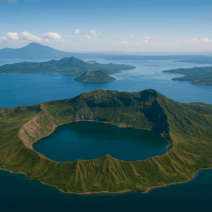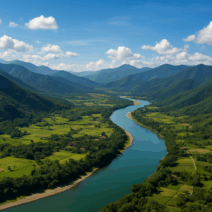QUICK SUMMARY
A lively look at Dagupan’s Bangus Festival, known for its street dancing, culinary competitions, and the world-famous Milkfish Grill that celebrates the city’s top export.
Every April, the streets of Dagupan City come alive with color, music, and the mouthwatering aroma of freshly grilled bangus. Known as the Bangus Festival, this annual celebration pays tribute to the city’s most famous product: the prized Dagupan bangus, widely recognized as one of the best-tasting milkfish varieties in the Philippines. What began in the early 2000s as an initiative to boost local pride and tourism has grown into one of Northern Luzon’s most exciting cultural gatherings, drawing thousands of visitors each year.
The festival highlights not only the economic importance of bangus but also the cultural identity and communal spirit of Dagupenos. Through street dancing, culinary competitions, and community events, the Bangus Festival tells the story of a city deeply connected to its waters, its flavors, and its people.
The Significance of Dagupan Bangus
Bangus, or milkfish, is the Philippines’ national fish, but Dagupan’s variety is particularly renowned. The rich, brackish waters of the city’s rivers and coastal areas provide ideal conditions, imparting a clean, mildly sweet flavor that chefs and home cooks alike appreciate. For generations, bangus has been at the heart of local livelihood, shaping both the economy and the cuisine of Dagupan.
The Bangus Festival emerged as a way to honor this connection. It not only celebrates a product but also acknowledges the fish farmers, vendors, and families who rely on bangus as a cornerstone of daily life. The festival represents the city’s commitment to preserving tradition while promoting innovation in local aquaculture.
Bangus Festival Street Dancing
One of the highlights of the celebration is its street dancing competition, where performers move through Dagupan’s major streets wearing bright costumes inspired by aquatic life and Pangasinan culture. The routines are energetic and playful, often mimicking the movements of fish swimming or fishers casting nets.
The dances tell stories—both traditional and modern—about life by the water, the hard work of raising bangus, and the unity of the community. Visitors experience an explosion of sound and color as choreographed groups fill the roads with synchronized movements. For many, this event is the heart of the festival’s festive atmosphere.
The “Kalutan ed Dalan”: The World’s Longest Grill
Perhaps the most iconic element of the Bangus Festival is the “Kalutan ed Dalan,” which translates to “grilling on the street.” This event, introduced during the early years of the festival, once held the Guinness World Record for the longest barbecue grill, stretching along the city’s main streets.
During Kalutan ed Dalan, thousands of bangus are lined up on massive grills, tended by locals, chefs, home cooks, and visitors eager to participate. Smoke fills the air, the aroma is irresistible, and the entire city transforms into one giant outdoor kitchen. The event encourages creativity, with participants showcasing different marinades, stuffing techniques, and flavor profiles.
For travelers, it is both a culinary experience and a cultural celebration, giving them a taste of the city’s culinary pride in its most authentic form.
Bangus Culinary Competitions
Beyond grilling, the festival also highlights the versatility of bangus as an ingredient. Culinary competitions are held throughout the celebration, showcasing dishes ranging from traditional inihaw and relyenong bangus to innovative recipes that blend Pangasinan flavors with global influences.
Students, professionals, and local chefs compete for recognition, pushing the boundaries of creativity while preserving the fish’s natural flavors. These events reinforce Dagupan’s status as a culinary destination, especially for seafood lovers seeking fresh and high-quality ingredients.
Float Parades and Cultural Showcases
Colorful floats inspired by marine themes, local folklore, and Dagupan’s fishing heritage parade through the streets during the festival. Many floats incorporate bangus imagery, riverside scenes, or depictions of traditional fish pens known as kasilayans. The creativity and craftsmanship behind these floats make them a visual highlight.
Cultural showcases also take place in plazas and open spaces, featuring traditional music, Pangasinan folk performances, and storytelling sessions. These events help preserve the region’s cultural traditions and introduce them to a younger audience and visiting tourists.
Sports and Community Activities
The Bangus Festival is more than cultural shows and food—it is also a time for community bonding. Sports competitions, fun runs, talent shows, and outdoor activities gather participants from all walks of life. Water sports such as boat races highlight Dagupan’s riverine environment, adding variety to the celebration.
Local businesses, schools, and civic organizations also host events that encourage participation and collaboration, reflecting the festival’s role in strengthening community ties.
Tourism and Economic Impact
The festival significantly boosts tourism in Dagupan and contributes to the local economy. Hotels and restaurants experience increased bookings, while fish vendors and market sellers see a surge in demand. The events promote bangus on a national scale, reaffirming Dagupan’s reputation as the Milkfish Capital of the Philippines.
Beyond tourism revenue, the festival raises awareness about sustainable aquaculture practices, highlighting the city’s ongoing efforts to balance economic needs with environmental stewardship.
Why the Bangus Festival Stands Out
Unlike many Philippine festivals rooted primarily in religious traditions, the Bangus Festival takes inspiration from livelihood, culinary heritage, and civic pride. It celebrates a resource that has supported families for generations, while capturing the joyful energy characteristic of Filipino festivals.
The festival’s combination of food, culture, and community participation makes it one of the most unique and engaging celebrations in Luzon. Visitors leave with not just memories of vibrant parades, but also the unforgettable taste of Dagupan’s world-famous milkfish.





